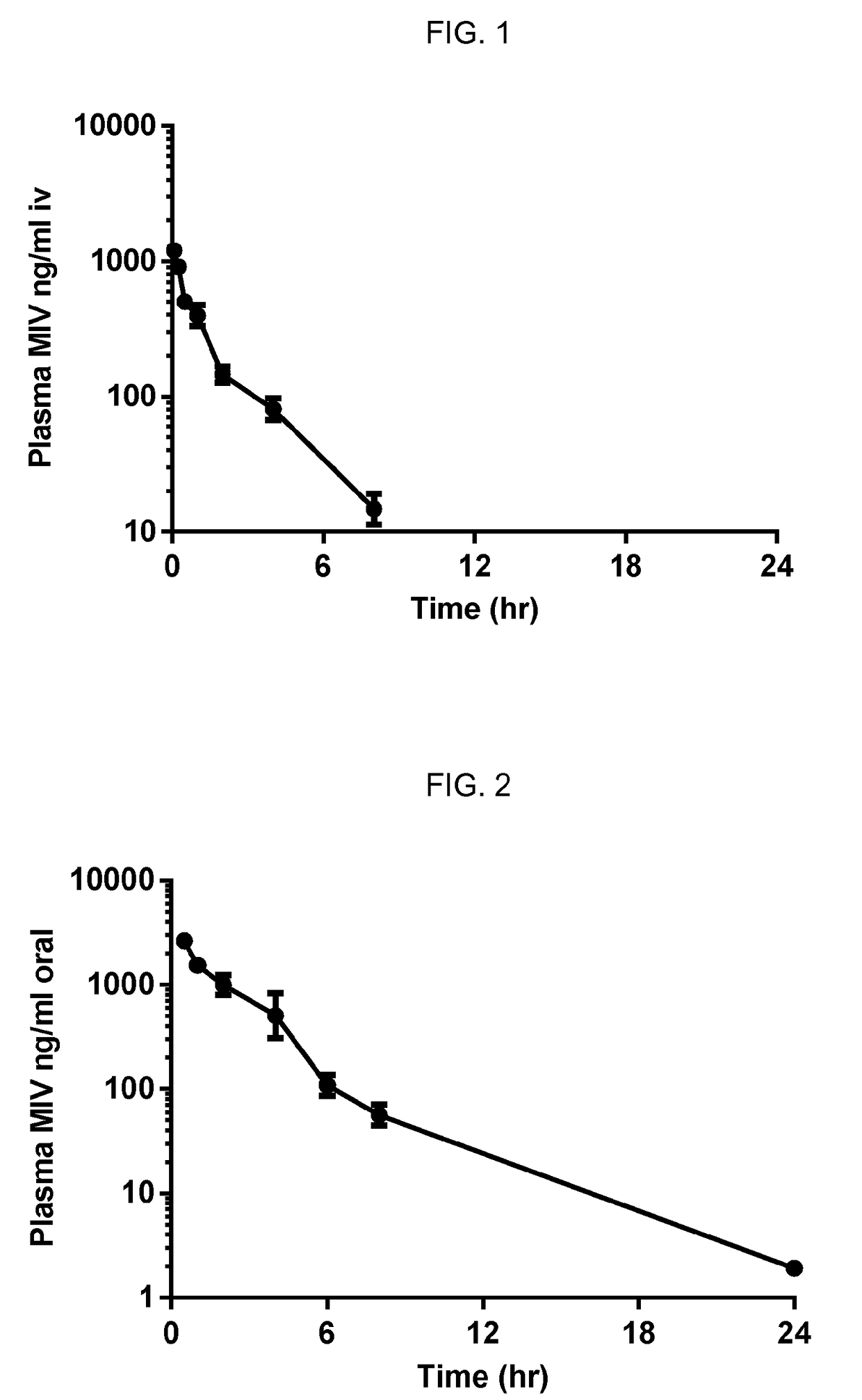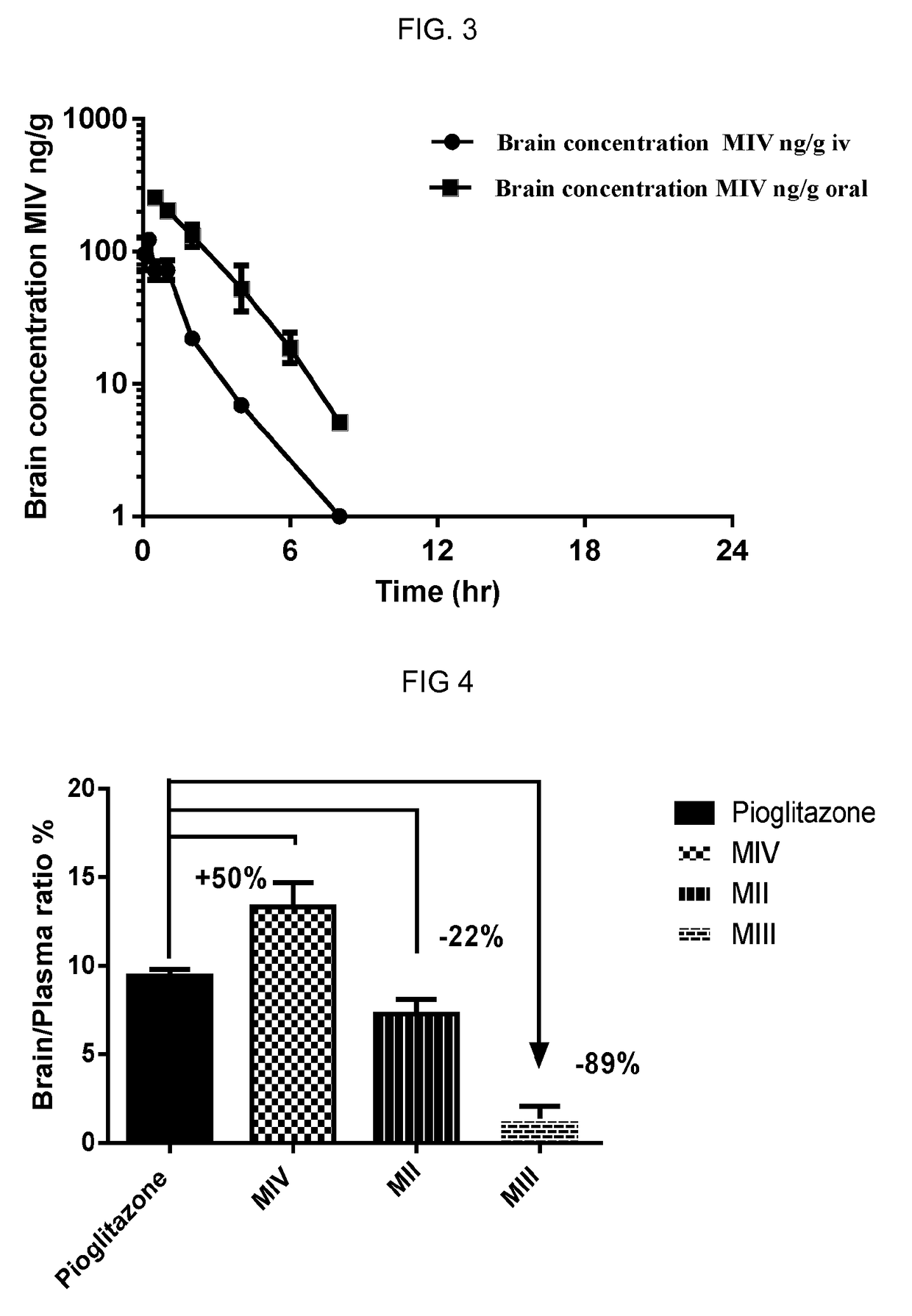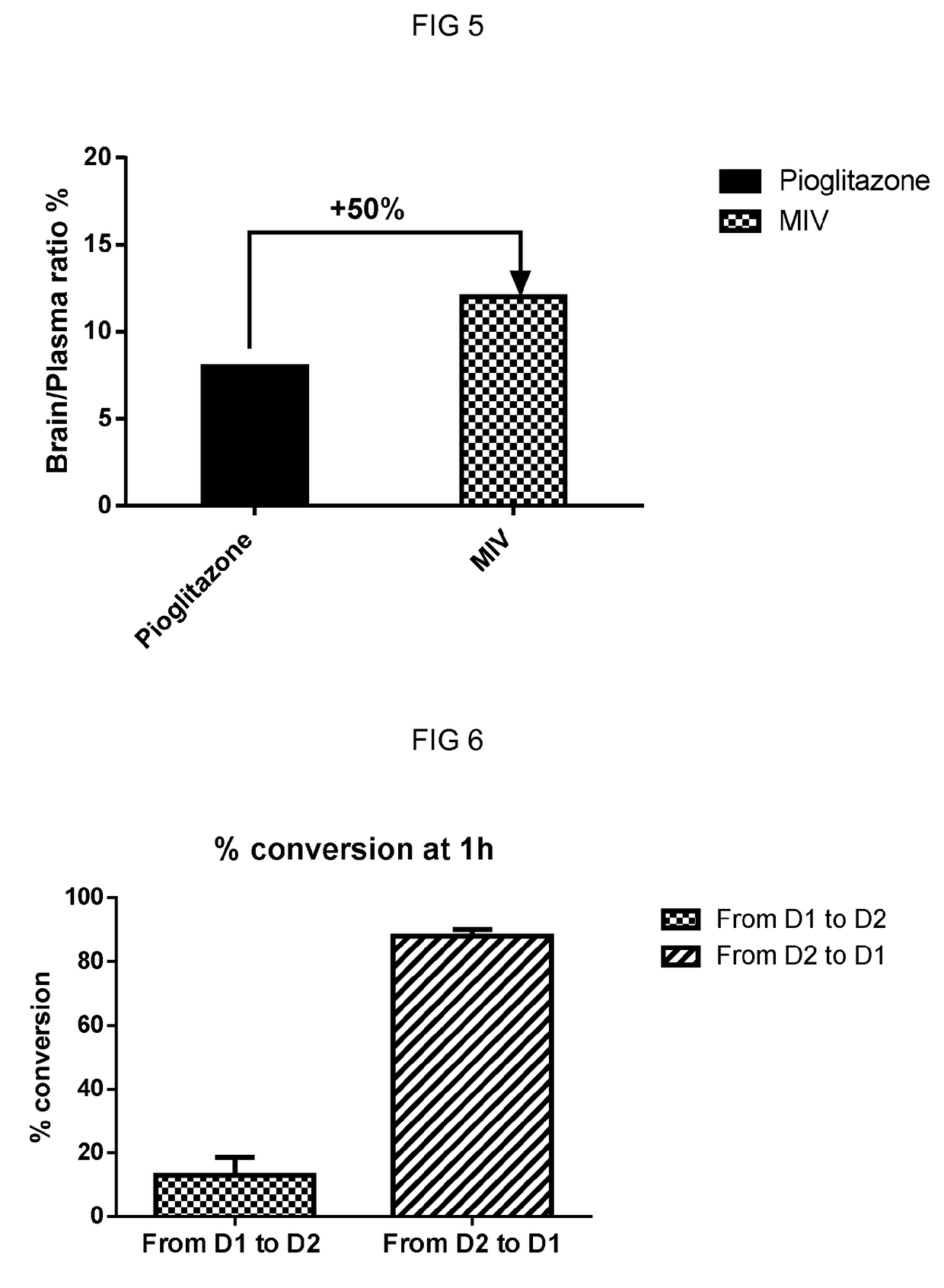2,4-thiazolidinedione derivatives in the treatment of central nervous system disorders
a technology of thiazolidinedione and derivatives, which is applied in the field of 2,4-thiazolidinedione derivatives as medicaments, can solve the problems of inability to cure, the process of neurodegeneration is not well understood, and the condition is progressive and often fatal, and achieves low systemic plasma clearance, good oral bioavailability, and good volume of distribution
- Summary
- Abstract
- Description
- Claims
- Application Information
AI Technical Summary
Benefits of technology
Problems solved by technology
Method used
Image
Examples
example 1
inetic Profile and Brain Distribution
[0139]Protocol: Pharmacokinetic parameters and brain distribution of 5-(4-(2-(5-(1-hydroxyethyl)pyridine-2-yl)ethoxy)benzyl)thiazolidine-2,4-dione (racemate or stereoisomers) following single oral (4.5 mg / kg) and intravenous (1 mg / kg) dose administration to male C57 BL / 6 mice were determined. Blood samples and brain samples were collected pre-dosing and different times post dosing for both oral and i.v pharmacokinetics. All samples were processed for analysis by protein precipitation using acetonitrile and analyzed with fit-for-purpose LC / MS / MS method. The lower limit of quantification (LLOQ) in plasma and brain for 5-(4-(2-(5-(1-hydroxyethyl)pyridine-2-yl)ethoxy)benzyl)thiazolidine-2,4-dione (1) is 0.99 ng / mL. Pharmacokinetic parameters were calculated using the non-compartmental analysis tool of Phoenix WinNonlin.
[0140]The results from these experiments are shown in FIG. 1, FIG. 2 and FIG. 3. The data clearly demonstrates that 5-(4-(2-(5-(1-hyd...
example 2
of Action: In Vitro Pharmacology
[0145]Protocol: To determine the mechanism of action through the agonism of PPAR gamma, a cellular functional assay was performed using a human recombinant cell line cotransfected with a PPRE luciferase reporter, PPAR-γ, RXR-α and coactivator DRIP205.
[0146]Transfected cells were treated with increasing doses of compounds. Luciferase activity was detected by alphascreen technology and normalized based on β-galactosidase activity. The results are expressed as the fold induction over the control (Rosiglitazone 10 μM). Dose response curves were obtained. Results were calculated as EC50 that is the concentration of compound that provokes 50% control agonist response.
[0147]EC50 racemic 5-(4-(2-(5-(1-hydroxyethyl)pyridine-2-yl)ethoxy)benzyl)thiazolidine-2,4-dione=9.3 μM
[0148]The results from these experiments indicate that racemic 5-(4-(2-(5-(1-hydroxyethyl)pyridine-2-yl)ethoxy)benzyl)thiazolidine-2,4-dione and its stereoisomers have varying PPAR gamma agoni...
example 3
[0149]General Experimental Conditions
[0150]1H spectra were recorded on 400 MHz Varian NMR spectrometer using appropriate deuterated solvents. Chromatographic analyses of the compounds were conducted using appropriate methods as shown below.
[0151]LCMS Method
[0152]Column: Agilent Zorbax 3.5 μm, SB-C8 (4.6×75 mm); wavelength: 210 nm; flow: 1 mL / min; run time: 7 min; mobile phase-gradient (t / % B): 0 / 30, 3.5 / 95, 5 / 95, 5.5 / 30, 7 / 30 [A: Water (0.1% formic acid); B: Acetonitrile]; MASS: Agilent-single quad-multimode-APCI-ESI.
[0153]Chiral HPLC Method
[0154]Column: Chiralpak-IA 5 μm (4.6 mm×250 mm); wavelength: 210 nm; flow: 0.7 mL / min; run time: 30 min; mobile phase-isocratic: 65 / 35 (A / B) [A: n-Hexane (0.05% triethylamine and 0.1% trifluroacetic acid), B: Isopropyl alcohol].
[0155]Chiral Prep-HPLC Method
[0156]Column: Chiralpak-IA 5 Lm (250×20 mm); wavelength: 254 nm; flow: 18 ml / min; run time: 60 min; mobile phase-isocratic 50 / 50 (A / B): A: n-Hexane, B: EtOH (0.05% triethylamine).
[0157]HPLC Met...
PUM
| Property | Measurement | Unit |
|---|---|---|
| temperature | aaaaa | aaaaa |
| system disorder | aaaaa | aaaaa |
| disorder | aaaaa | aaaaa |
Abstract
Description
Claims
Application Information
 Login to View More
Login to View More - R&D
- Intellectual Property
- Life Sciences
- Materials
- Tech Scout
- Unparalleled Data Quality
- Higher Quality Content
- 60% Fewer Hallucinations
Browse by: Latest US Patents, China's latest patents, Technical Efficacy Thesaurus, Application Domain, Technology Topic, Popular Technical Reports.
© 2025 PatSnap. All rights reserved.Legal|Privacy policy|Modern Slavery Act Transparency Statement|Sitemap|About US| Contact US: help@patsnap.com



